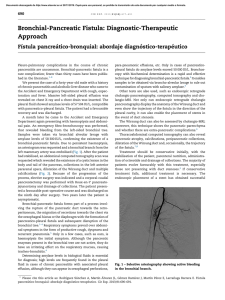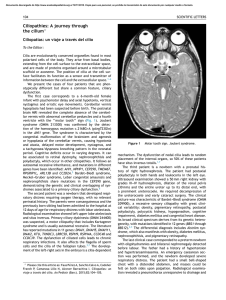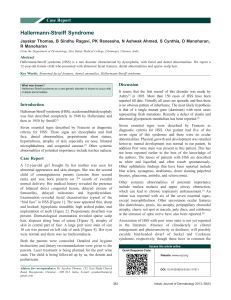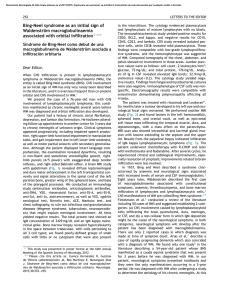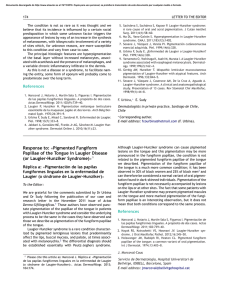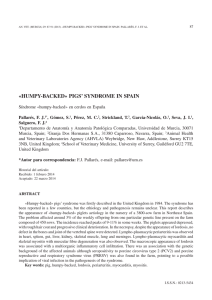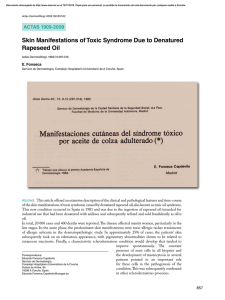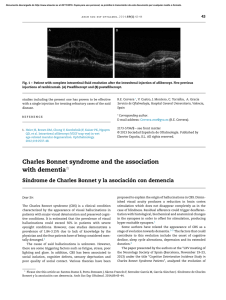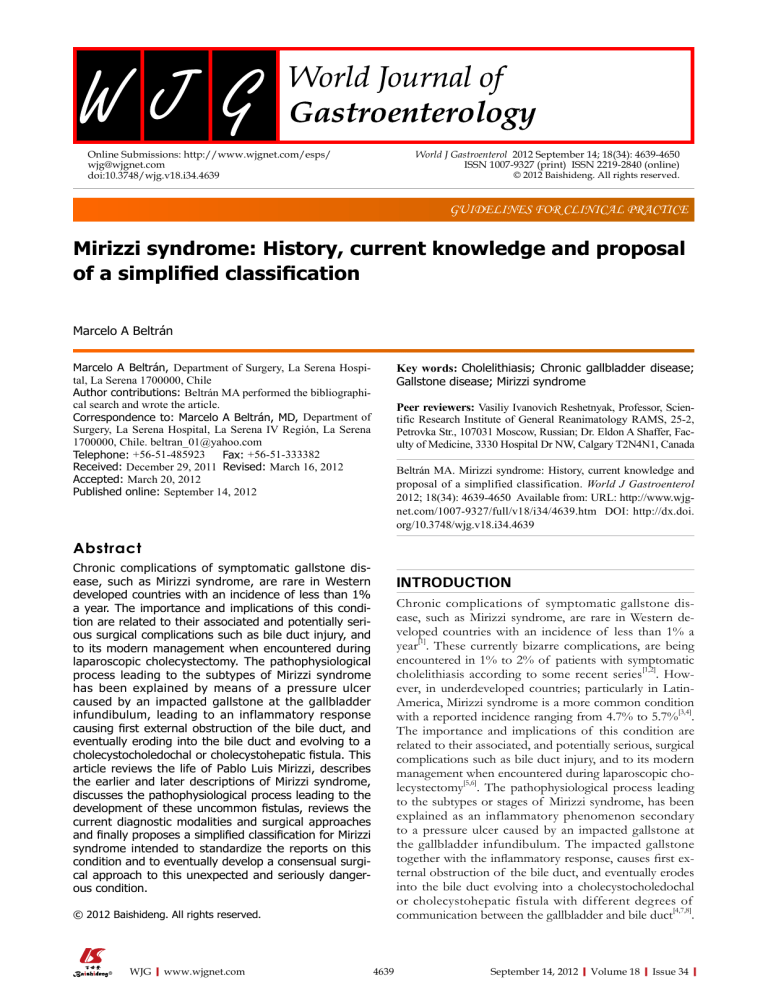
World J Gastroenterol 2012 September 14; 18(34): 4639-4650 ISSN 1007-9327 (print) ISSN 2219-2840 (online) Online Submissions: http://www.wjgnet.com/esps/ [email protected] doi:10.3748/wjg.v18.i34.4639 © 2012 Baishideng. All rights reserved. GUIDELINES FOR CLINICAL PRACTICE Mirizzi syndrome: History, current knowledge and proposal of a simplified classification Marcelo A Beltrán Key words: Cholelithiasis; Chronic gallbladder disease; Gallstone disease; Mirizzi syndrome Marcelo A Beltrán, Department of Surgery, La Serena Hospital, La Serena 1700000, Chile Author contributions: Beltrán MA performed the bibliographical search and wrote the article. Correspondence to: Marcelo A Beltrán, MD, Department of Surgery, La Serena Hospital, La Serena IV Región, La Serena 1700000, Chile. [email protected] Telephone: +56-51-485923 Fax: +56-51-333382 Received: December 29, 2011 Revised: March 16, 2012 Accepted: March 20, 2012 Published online: September 14, 2012 Peer reviewers: Vasiliy Ivanovich Reshetnyak, Professor, Scien- tific Research Institute of General Reanimatology RAMS, 25-2, Petrovka Str., 107031 Moscow, Russian; Dr. Eldon A Shaffer, Faculty of Medicine, 3330 Hospital Dr NW, Calgary T2N4N1, Canada Beltrán MA. Mirizzi syndrome: History, current knowledge and proposal of a simplified classification. World J Gastroenterol 2012; 18(34): 4639-4650 Available from: URL: http://www.wjgnet.com/1007-9327/full/v18/i34/4639.htm DOI: http://dx.doi. org/10.3748/wjg.v18.i34.4639 Abstract Chronic complications of symptomatic gallstone disease, such as Mirizzi syndrome, are rare in Western developed countries with an incidence of less than 1% a year. The importance and implications of this condition are related to their associated and potentially serious surgical complications such as bile duct injury, and to its modern management when encountered during laparoscopic cholecystectomy. The pathophysiological process leading to the subtypes of Mirizzi syndrome has been explained by means of a pressure ulcer caused by an impacted gallstone at the gallbladder infundibulum, leading to an inflammatory response causing first external obstruction of the bile duct, and eventually eroding into the bile duct and evolving to a cholecystocholedochal or cholecystohepatic fistula. This article reviews the life of Pablo Luis Mirizzi, describes the earlier and later descriptions of Mirizzi syndrome, discusses the pathophysiological process leading to the development of these uncommon fistulas, reviews the current diagnostic modalities and surgical approaches and finally proposes a simplified classification for Mirizzi syndrome intended to standardize the reports on this condition and to eventually develop a consensual surgical approach to this unexpected and seriously dangerous condition. INTRODUCTION Chronic complications of symptomatic gallstone disease, such as Mirizzi syndrome, are rare in Western developed countries with an incidence of less than 1% a year[1]. These currently bizarre complications, are being encountered in 1% to 2% of patients with symptomatic cholelithiasis according to some recent series[1,2]. However, in underdeveloped countries; particularly in LatinAmerica, Mirizzi syndrome is a more common condition with a reported incidence ranging from 4.7% to 5.7%[3,4]. The importance and implications of this condition are related to their associated, and potentially serious, surgical complications such as bile duct injury, and to its modern management when encountered during laparoscopic cholecystectomy[5,6]. The pathophysiological process leading to the subtypes or stages of Mirizzi syndrome, has been explained as an inflammatory phenomenon secondary to a pressure ulcer caused by an impacted gallstone at the gallbladder infundibulum. The impacted gallstone together with the inflammatory response, causes first external obstruction of the bile duct, and eventually erodes into the bile duct evolving into a cholecystocholedochal or cholecystohepatic fistula with different degrees of communication between the gallbladder and bile duct[4,7,8]. © 2012 Baishideng. All rights reserved. WJG|www.wjgnet.com 4639 September 14, 2012|Volume 18|Issue 34| Beltrán MA. Mirizzi Syndrome Based on this knowledge, and after an extensive experience treating this uncommon condition, a new concept regarding Mirizzi syndrome and gallstone ileus have been developed relating both conditions and modifying the classic Csendes classification[4,7,8]. Figure 1 Professor Pablo Luis Mirizzi (1893-1964). WHO WAS PABLO LUIS MIRIZZI? Pablo Luis Mirizzi was a surgeon from Argentina, born in the city of Cordoba on January 25, 1893 and deceased in the same city on August 28, 1964 (Figure 1). Mirizzi, graduated from the Medical Sciences School at the National University of Cordoba in 1915; and in 1916 at 23 years of age defended his “Tesis Doctoral” entitled “Anemia Esplénica Cirrógena”. Mirizzi was a brilliant young doctor studying under the most prominent Argentinean surgeons of their time. At the age of 25 years; in 1918, he was appointed Assistant Professor of Surgery at the same university where he had studied. During the next few years, Mirizzi traveled abroad and visited the most important and renowned surgical centers of his time in the United States of America and Europe. After he returned to Argentina, he developed his professional, scientific and academic career and in 1926 he became Full Professor of Surgery[9,10]. On June 18, 1931 Mirizzi performed the first operative cholangiography which is considered his main contribution to modern biliary surgery[9-11]. The first description made by Mirizzi compatible with the syndrome that bears his name, was published in 1940 in an article dealing with a “physiologic sphincter of the hepatic duct”[12]; The most known and cited description of his syndrome was published in 1948 postulating the functional spasm of the “common hepatic duct sphincter”, which he believed existed within the common hepatic duct, as the cause of the obstructive jaundice in patients with chronic or acute gallstone disease[13]. The syndrome that Mirizzi described, consisted of an uncommon and benign cause of obstructive jaundice, caused by a gallstone impacted at the Hartmann’s pouch, gallbladder infundibulum or the cystic duct and its associated inflammatory process, thereby causing obstruction of the common hepatic duct[9,10,12,13]. Mirizzi, believed that the obstruction of the common hepatic duct was rather functional, and that the mechanical obstruction of the gallbladder infundibulum and consequent inflammatory process predisposed to the contraction of a “muscular sphincter” located in the common hepatic duct[9,10,12-14]. However, current knowledge has dismissed the presence of any sphincter, or even smooth muscle, in the common hepatic duct[10,14,15]. Pablo Luis Mirizzi was recognized during his lifetime as a great surgeon, a great teacher, and a great humanitarian physician. In 1955 he was named Honorary Professor of the National University of Cordoba, and in 1956, the “Sociedad Argentina de Cirugía” honored him the title “Cirujano Maestro”. Afterwards, numerous surgical academies and societies around the world awarded him honorary memberships as well as many other honors. In 1957, the Assembly of the International Society of Surgery named WJG|www.wjgnet.com Professor Mirizzi as President of the International Surgical Congress that was to be celebrated in Munich in 1959; this was the first time that a Latin-American surgeon had received such a high honor. Pablo Luis Mirizzi died in his city, Cordoba, on August 28, 1964. Besides his great contributions to surgery, he left his art collection to the “Museo Provincial de Bellas Artes Emilio Caraffa”, donated his medical library to the Medical Sciences School of the National University of Cordoba, and established a biennial traveling surgical scholarship in biliary surgery to be awarded to distinguished young surgeons from Cordoba, Argentina[9,10]. EARLY AND LATEST DESCRIPTIONS OF THE “MIRIZZI SYNDROME” The most common complications of chronic gallstone disease are acute cholecystitis, acute pancreatitis and acute cholangitis[1]. Other benign complications are unusual and include Mirizzi syndrome and gallstone ileus among others[1,8]. The bizarre complications of gallstone disease described in the surgical literature of the late XIX century and early XX century are seldom found today due to the widespread use and availability of ultrasonography, which have led to early diagnosis and early treatment for patients with gallstone disease, consequently avoiding the development of those late complications[4,8]. Professor Mirizzi, however, was not the first to describe the characteristics of benign obstruction of the bile duct with resultant jaundice. Partial duct obstruction secondary to an impacted gallstone and its associated inflammatory process was first described by Kehr[16] in 1905 and by Ruge[17] in 1908. Mirizzi[12] reported his syndrome for the first time in 1940, and in 1941 Levrat et al[18] reported other cases. Finally the famous article that established the eponym of Mirizzi[13] for this condition was published in 1948. At the same time, other authors began to report other forms of complications related to long-standing gallstone disease, and in 1942, Puestow[19] reported the first fistula between the gallbladder and the choledochus in a series of 16 patients with “spontaneous internal biliary fistulas”, he described fistulas between the gallbladder and other abdominal and thoracic organs such as stomach, duodenum, colon and bronchus. 4640 September 14, 2012|Volume 18|Issue 34| Beltrán MA. Mirizzi Syndrome Gallbladder Cholecystocholedochostomy Common bile duct Cholecystocholedochostomy Cholecystoduodenostomy Figure 2 Albert Behrend described this case that corresponded to Mirizzi syndrome type Ⅳ according to the Csendes classification. The gallstone surrounded by an inflammatory process was clearly dilating the cystic duct fusing the gallbladder to the bile duct (original drawing from Annals of Surgery 1950; 132, page 300)[20]. Figure 4 This illustration by Behrend clearly depicts Mirizzi syndrome type Ⅴ according to Csendes. The continuous inflammatory process affecting the gallbladder has obliterated the cystic duct, and the gallstones compressed inside the gallbladder, have produced pressure ulcers over the gallbladder walls eroding into the bile duct and the duodenum (original drawing from Annals of Surgery 1950; 132, page 300)[20]. the gallstones through the gallbladder wall into the bile duct. Both authors proposed similar classifications for this syndrome. Recently, the Mirizzi syndrome classification originally described by Csendes et al[7] was expanded to include bilioenteric fistulae; this addition was recently validated by Beltran et al[4]. Obliterated cystic duct PATHOPHYSIOLOGY The current concept of Mirizzi syndrome, includes the external compression of the bile duct and the later development of cholecystobiliary and cholecystoenteric fistulas as different stages of the same disease process[4,7,8]. Mirizzi syndrome can be caused by an acute or chronic inflammatory condition secondary to a single large gallstone or multiple small gallstones impacted in the Hartmann’s pouch or in the gallbladder infundibulum and cystic duct[1,4,7,8,14,25-37]. A long cystic duct; parallel to the bile duct, and a low insertion of the cystic duct into the bile duct, have been regarded as predisposing factors for the development of Mirizzi syndrome[1,25,31,32]. Recurrent impaction of gallstones will lead to repeated episodes of acute cholecystitis and will render the gallbladder initially distended with thick inflamed walls. Eventually the gallbladder will become contracted and atrophic, having thicker fibrotic walls if contracted. When the gallbladder becomes atrophic, it will degenerate into thick or thin atrophic walls; and in some cases the walls would be intimately adherent to the contained gallstones[1,2,25,27,37]. The close proximity of the acutely or chronically inflamed gallbladder to the bile duct could eventually lead to the fusion of their walls by edematous inflammatory tissue that in time will become fibrotic contributing to the external compression of the bile duct and leading to the characteristic obstructive jaundice seen with this condition[1,2,7,8,37], this late process could be acute or chronic[1,4,7,8,14,25-37]. The cholecystobiliary fistula has been explained by two mechanisms. The first mechanism, proposes that the Cholecystocholedochostomy Figure 3 Another case described by Behrend. The cystic duct has become obliterated due to a chronic inflammatory process and the gallstones have eroded the gallbladder wall and formed a cholecystobiliary fistula corresponding to Mirizzi syndrome type Ⅱ according to the Csendes classification (original drawing from Annals of Surgery 1950; 132, page 300)[20]. Another important and overlooked article was published in 1950 by Behrend et al[20], in this publication they described 3 patients with cholecystobiliary fistulas; the first patient had a gallstone eroding through a much dilated cystic duct (Figure 2). The second patient had a fistula between the gallbladder wall and the choledochal wall with the cystic duct obliterated (Figure 3). The third patient had a double fistula between the gallbladder and the common hepatic duct, and between the gallbladder and the duodenum through the gallbladder wall (Figure 4), constituting the first description of what is currently known as Mirizzi Syndrome type Ⅴ[4]. Soon, other authors described other cases of cholecystobiliary fistulas, Patt et al[21] in 1951 reported two cases, also Mirizzi[22] in 1952 reported on another four cases, and by 1975 Corlette et al[23] reported on another 24 cases. In 1982 McSherry et al[24] and in 1989 Csendes et al[7], published seminal articles describing the pathophysiological process involved in the development of Mirizzi syndrome, including the initial external compression of the bile duct by impacted gallstones until the erosion of WJG|www.wjgnet.com 4641 September 14, 2012|Volume 18|Issue 34| Beltrán MA. Mirizzi Syndrome impacted gallstone and its secondary inflammatory process will lead to complete obliteration of the cystic duct, the impacted gallstone seeking to pass into the bile duct will develop a pressure ulcer that ultimately will erode the gallbladder wall and bile duct wall forming a communication between both lumens[1,8,23,27,37]. The second mechanism proposes that the impacted gallstone at the gallbladder infundibulum progressively dilates the cystic duct, leading to shortening, contraction and fibrosis of this duct and finally forming a large communication between the gallbladder and bile duct[2,23,27,37]; and even fusing the gallbladder to the adjacent bile duct[14,27,37]. If the inflammatory process continues or if a chronic inflammatory process becomes established, the gallstones will cause a pressure ulcer and necrosis, eroding into the bile duct and producing a cholecystobiliary fistula[1,2,4,8,23,27,37]. In some cases, the gallstones will also cause other pressure ulcers and concomitantly with the cholecystobiliary fistula a cholecystoenteric fistula will form[2,4,8,20]. Some characteristics of this distorted anatomy can be consistently found in Mirizzi syndrome. Consequently, based on over 70 years of publications on the subject, we may describe certain “anatomy” of Mirizzi syndrome. First, an atrophic gallbladder with either thick or thin walls[25,26,37], with impacted gallstones at the infundibulum or at the Hartmann’s pouch, occasionally found firmly attached to the gallbladder wall[26,30,32,37]. Second, an obliterated cystic duct which is frequently found[2,25,30,37]. Third, a long cystic duct running parallel to the common bile duct with low insertion which has been described as a risk factor for Mirizzi syndrome[1,25,26,30,31,34]. Fourth, another anatomic variation thought to predispose to Mirizzi syndrome has been related to a normal short cystic duct[2,26,30]. Fifth, partial obstruction by external compression of the bile duct or by a gallstone eroding into the bile duct originating from the gallbladder. Sixth, a normal caliber distal bile duct with normal thickness walls[2,25,32]. Seventh, a dilated proximal bile duct with thick inflamed walls[2,25,32]. Eighth, an anomalous communication between the gallbladder and the bile duct[28]. Finally, an anomalous communication between the gallbladder and the stomach, duodenum, colon, or other abdominal viscera[4,8,28] (Table 1). the most common form of clinical presentation of Mirizzi syndrome is obstructive jaundice (60%-100%), accompanied by abdominal pain over the right upper abdominal quadrant (50%-100%), and fever in the context of a patient with known or suspected gallstone disease[1,14,26-33,35-37]. A previous recent history of jaundice can sometimes be elicited. Frequently, patients with Mirizzi syndrome present in the setting of acute cholecystitis, acute cholangitis or acute pancreatitis[1,2,27,28,33,35]. Recently, Mirizzi syndrome in the setting of gallstone ileus has been described and validated as another clinical presentation that surgeons must bear in mind[4,8]. The most common laboratory finding present in these patients is hyperbilirubinemia. Other laboratory abnormalities are elevated aminotransaminase levels and leukocytosis, frequently seen when acute cholecystitis, cholangitis or pancreatitis is present[1,25,26,28,29,33,35]. Recently, extremely high levels of the malignancy marker, CA19-9, have been consistently found in patients with Mirizzi syndrome type Ⅱ or higher[38-40]. Consequently, the CA19-9 must be interpreted cautiously in patients with suspected biliary malignancy, because if Mirizzi syndrome is not ruled out, the patient would be incorrectly labeled as having biliary tract or gallbladder cancer and could miss the opportunity for curative surgery. The differential diagnosis of Mirizzi syndrome includes any other benign or malignant cause of obstructive jaundice, such as gallbladder cancer, cholangiocarcinoma, pancreatic cancer, sclerosing cholangitis, metastatic disease, and others[1,27,31,37]. DIAGNOSIS Preoperative diagnosis of Mirizzi syndrome followed by thoughtful surgical planning is of utmost importance[6]. The incidence of bile duct injuries in patients operated on with Mirizzi syndrome without preoperative diagnosis could be as high as 17%[14]. Preoperative diagnosis of Mirizzi syndrome is difficult and can be made in only 8% to 62.5% of patients[26,29,37,41]. If preoperative diagnosis is not made, intraoperative recognition and proper management is essential. Inadequate recognition of this condition leads to high preoperative morbidity and mortality[14]. The diagnosis of Mirizzi syndrome is based in the clinical characteristics previously described and a high index of suspicion or surgical intuition, which might be complemented by radiological images and endoscopic procedures. SYMPTOMATOLOGY AND OTHER CLINICAL MANIFESTATIONS Patients with Mirizzi syndrome present with a mean age varying from 53 to 70 years, and are female with a frequency of around 70% of all cases[2,4,5,7,25,26,28,32,36]. However, it may occur at any age and in any patient with gallstones[4,27,32]. Long-standing gallstone disease, with a median of 29.6 years of disease, has been reported for patients with Mirizzi syndrome[4]. Mirizzi syndrome frequently presents in an acute form; however, the chronic form is equally or an even more common form of presentation[35]. Although the clinical presentation of Mirizzi syndrome is unspecific, WJG|www.wjgnet.com Ultrasonography A contracted gallbladder with thick or extremely thin walls with one large gallstone or multiple smaller gallstones impacted in the infundibulum may be appreciated[32]. The hepatic duct would be dilated in its extra and intrahepatic portions above the level of the obstruction site, and the common bile duct would be within normal size under the level of obstruction[1,14,28,32]. The reported diagnostic accuracy for ultrasonography in Mirizzi syn- 4642 September 14, 2012|Volume 18|Issue 34| Beltrán MA. Mirizzi Syndrome Table 1 Mirizzi syndrome “anatomy” Gallbladder Cystic duct [25,26,37] Thick or thin atrophic walls Obliterated cystic duct [2,25,37] Impacted gallstones at the infundibulum Occasional absence of cystic duct[2,25,30] or at the Hartmann’s pouch[26,30,32,37] A long cystic duct running parallel to the common bile duct with low insertion[1,25,26,30,31,34] A normal short cystic duct[2,26,30] drome is 29%[29], with a reported sensitivity varying from 8.3% to 27%[33,41]. Fistulas Partial obstruction by external compression or by a gallstone eroding into the bile duct Normal caliber distal bile duct with walls of normal thickness[2,25,32] A dilated proximal bile duct with thick inflamed walls[2,25,32] Cholecystocholedochal fistula[28] Cholecystoenteric fistula[4,8,28] nosed during surgery[29]. Surgical characteristics include the presence of a shrunken gallbladder with distorted anatomy or a dilated gallbladder with thick walls and a large stone, or multiple gallstones, impacted at the gallbladder neck or infundibulum, an obliterated Calot’s triangle, a dense fibrotic mass at the Calot’s triangle, and dense adhesions at the subhepatic space. Intraoperative cholangiography could be useful and help to confirm the diagnosis, determine the location and size of the fistula, detect bile duct stones, and detect whether there is any loss of integrity of the bile duct wall[14]. However, intraoperative cholangiography may be difficult to perform and persistent dissection at the Calot’s triangle area may result in a bile duct injury. Intraoperative ultrasonography has been reported to be a useful tool to identify the anatomy of the biliary tree and help with an accurate dissection of the bile duct in an inflamed area[14,28]. Computed tomography Abdominal computed tomography (CT) can identify the gallbladder and measure its wall thickness and the bile duct dilatation. However, the presence of periductal inflammation can be misinterpreted as gallbladder cancer[27]. The radiological signs elicited by CT are not specific. The main utility of CT would be the exclusion of malignancy in the porta hepatis area or in the liver[1,14,32]. Magnetic resonance Cholangioresonance or magnetic resonance cholangiopancreatography (MRCP) is a useful tool to demonstrate extrinsic compression of the bile duct and to determine whether a fistula is present or not. Moreover, it is useful to rule out choledocholithiasis and other causes of bile tract obstruction. Some typical features of Mirizzi syndrome can be shown by MRCP such as the extrinsic narrowing of the common hepatic duct, a gallstone in the cystic duct, dilatation of the intrahepatic and common hepatic ducts, and a normal choledochus. Magnetic resonance imaging can also show the extent of the inflammatory process surrounding the gallbladder and has the advantage of avoiding the complications associated with endoscopic cholangiography[14]. However, the diagnostic accuracy for MRCP is 50%[29]. GALLSTONE ILEUS AND MIRIZZI SYNDROME The first description of gallstone ileus was made by the notable anatomist Thomas Bartolin in 1654 as a disease of elderly and debilitated people. In 1890 Courvoisier[42] described 131 cases with a surgical mortality rate approaching 50%. Gallstone ileus is classically described as the impaction of one or more gallstones in the small bowel, frequently at the distal ileum[43]. However, an interesting form of gallstone ileus is the obstruction of the duodenum by an impacted gallstone causing gastric retention syndrome, first described in 1770 by Beaussier, and later by Bonnet in 1841 and by Bouveret[44] in 1896. Gallstone ileus accounts for 1% to 4% of all mechanical small bowel obstructions and for up to 25% of small bowel obstructions in patients older than 65 years, with a female preponderance[43]. The pathophysiology of gallstone ileus resembles that of Mirizzi syndrome. An episode of acute cholecystitis triggers a chronic inflammatory process causing a pressure ulcer by the offending gallstones and eventually eroding through the gallbladder wall into the bowel wall forming a cholecystoenteric fistula and allowing the passage of a single or multiple gallstones[1,2,4,7,8]. These similar pathological processes between cholecystoenteric fistula and Mirizzi syndrome with cholecystocholedochal fistula, were related in 2005 by Beltrán et al[8], constituting the basis for the addition by Csendes of a Endoscopic retrograde cholangiopancreatography Endoscopic retrograde cholangiopancreatography (ERCP) is an invasive procedure not only useful to confirm the presence of Mirizzi syndrome with or without cholecystobiliary or cholecystoenteric fistulae, but also for therapeutic means allowing stone retrieval, stent placement and other procedures[1,14,28,41]. The diagnostic accuracy of Mirizzi syndrome with this method reaches around 55% to 90%[29,41], with a failure rate ranging from 5% to 10%[33,41]. The features of ERCP in Mirizzi syndrome include a narrowing or curvilinear extrinsic compression involving the lateral portion of the distal common hepatic duct with proximal ductal dilatation and normal distal caliber[14,27,32,41]. Intraoperative diagnosis Over 50% of patients with Mirizzi syndrome are diag- WJG|www.wjgnet.com Bile duct 4643 September 14, 2012|Volume 18|Issue 34| Beltrán MA. Mirizzi Syndrome Table 2 Mirizzi syndrome milestones and historical classification Author Puestow[19], 1942 Mirizzi[13], 1948 Corlette et al[23], 1975 McSherry et al[24], 1982 Csendes et al[7], 1989 Csendes et al[4], 2008 External compression of common hepatic duct Cholecystocholedochal fistula Cholecystoenteric fistula Mirizzi Ⅰ Mirizzi Ⅰ Mirizzi Ⅰ Mirizzi Ⅰ Mirizzi Ⅱ Mirizzi Ⅱ (Fistula type I and Ⅱ) Mirizzi Ⅱ Mirizzi II, Ⅲ, Ⅳ Mirizzi Ⅱ, Ⅲ, Ⅳ - Ⅲ consists of a cholecystobiliary fistula involving up to two-thirds of the bile duct circumference. Mirizzi syndrome type Ⅳ is a cholecystobiliary fistula with complete destruction of the bile duct wall with the gallbladder completely fused to the bile duct forming a single structure with no recognizable dissection planes between both biliary tree structures. In 2007, Csendes added one more type to his classification that was later validated by Beltran and Csendes in 2008[4]; the Mirizzi type Ⅴ, which includes the presence of a cholecystoenteric fistula together with any other type of Mirizzi. Furthermore, Mirizzi type Ⅴa includes a cholecystoenteric fistula without gallstone ileus and Mirizzi type Ⅴb refers to a cholecystoenteric fistula complicated by gallstone ileus[4]. A simple historical comparison between the most well-known Mirizzi syndrome classifications is depicted in Table 2. Other lesser known classification systems have been described over the last 25 years; such as acute vs chronic variant, anatomic variant of cystic duct vs no anatomic variant of cystic duct, and obstruction due to gallstones vs obstruction due to inflammation[14,30,35]. The incidence of the different types of Mirizzi syndrome according to Beltrán and Csendes[4] is detailed in Table 3. Mirizzi type Ⅰ is fairly common (10.5% to 51%) and Mirizzi Ⅳ is rather uncommon (1% to 4%). Mirizzi Ⅴ, however, could be present in up to 29% patients with any other type of Mirizzi. Recently, some authors have used the new addition to the former Csendes classification to describe their patients with complex cholecystobiliary fistulas and associated cholecystoenteric fistulas[47]. Table 3 Incidence of the different types of Mirizzi syndrome according to Csendes 2007 classification Type of Mirizzi Ⅰ Ⅱ Ⅲ Ⅳ Ⅴ Incidence (%) [4,7,14,28,29] 10.5-78 15-41 3-44 1-4 29 fifth grade to his widely known classification[7], which was later validated in 2008 by Beltrán et al[4]. An interesting fact regarding this relationship between Mirizzi syndrome and cholecystoenteric fistula, is that many authors have previously described Mirizzi syndrome associated to fistulas communicating the gallbladder with the duodenum, colon, stomach or jejunum, failing to describe an association between these two conditions[28,45,46]. CLASSIFICATION Before recognition of external compression of the bile duct and cholecystobiliary fistula as different evolving stages of the same disease process during the decade of 1980; in 1975, Corlette et al[23] classified the cholecystocholedochal fistulas in two types. Type Ⅰ was defined when the fistula involved the Hartmann´s pouch and the bile duct. Type Ⅱ was defined when the gallstone dilated and eroded the cystic duct into the bile duct. McSherry et al[24] in 1982, classified the Mirizzi syndrome into two types based on ERCP findings. Type Ⅰ involves the external compression of the bile duct by a large stone or stones impacted in the cystic duct or in the Hartmann’ s pouch. Type Ⅱ consists of a proper cholecystobiliary fistula, caused by a gallstone or gallstones that have eroded into the bile duct. In 1989 Csendes et al[7], modified the classification of McSherry by dividing Mirizzi syndrome into four types. Csendes classification (Figure 5) further categorized the cholecystobiliary fistula according to the extent of bile duct destruction. Csendes type Ⅰ corresponds to McSherry type Ⅰ, the external compression of the bile duct by an impacted gallstone in the gallbladder infundibulum or cystic duct. Mirizzi syndrome type Ⅱ consists of a cholecystobiliary fistula resulting from erosion of the bile duct wall by a gallstone, the fistula must involve less than one-third of the circumference of the bile duct. Mirizzi syndrome type WJG|www.wjgnet.com Mirizzi Ⅴa, Ⅴb TREATMENT Patients with Mirizzi syndrome constitute a formidable challenge and their surgical treatment a test to any surgeon’s ability and dexterity[8]. The treatment of Mirizzi syndrome is surgical. Mirizzi syndrome is important to surgeons because preoperative diagnosis is not always possible and because the surgical treatment of this condition is associated with a significantly increased risk of bile duct injury[48-56]. Besides, the severe inflammatory process with thick dense hard adhesions and associated edematous tissues distort the anatomy[37,48,51,53,55]. Additionally, the presence of a cholecystobiliary fistula further increases the risk of biliary duct injury[48,52,53]. During the operation, dissection of the Calot’s triangle may lead to bile duct injury or excessive bleeding and other morbidity 4644 September 14, 2012|Volume 18|Issue 34| Beltrán MA. Mirizzi Syndrome A C B D E Figure 5 Mirizzi syndrome type Ⅰ to type Ⅴ. A: Mirizzi type Ⅰ is the extrinsic compression of the common bile duct by an impacted gallstone; B: Mirizzi type Ⅱ consists of a cholecystobiliary fistula involving one third of the circumference of the bile duct; C: In Mirizzi type Ⅲ, the cholecystobiliary fistula compromises up to twothirds of the circumference of the bile duct; D: In Mirizzi type Ⅳ, the cholecystobiliary fistula has destroyed the bile duct wall, and comprises the whole circumference of the bile duct; E: Mirizzi type V corresponds to any type of Mirizzi associated with a bilioenteric fistula with or without gallstone ileus (original drawings from World Journal of Surgery 2008; 32, pages 2239 to 2241)[4]. such as sepsis, delayed bile duct stricture, and secondary biliary cirrhosis[14,26,28,48,53]. The surgical treatment of Mirizzi syndrome avoids a truly standardized approach and must be individualized depending on the stage of the disease and the expertise of the surgical team[55]. However, some guidelines could be drawn and have been used during the last few years. erative cholangiography, a partial cholecystectomy leaving the gallbladder neck or infundibulum is performed and the gallbladder stump is closed with absorbable monofilament sutures over the bile duct. However, it must be kept in mind that sometimes a classic cholecystectomy could be performed. If a fistula is present (Mirizzi Ⅲ and Ⅳ), besides partial cholecystectomy, a biliary-enteric anastomosis could sometimes be performed between the duodenum and bile duct or between the bile duct and a loop of jejunum en-Y-de-Roux[7,14,29,33,37,48,51,55]. The rationale for a biliary-enteric anastomosis is that because of the continued inflammation of the gallbladder flap, strictures can develop, with an even greater risk for large cholecystocholedochal fistulas or badly damaged bile ducts[55]. Baer et al[48] have advocated an anastomosis between the partially resected gallbladder and the duodenum which they called “cholecysto-choledocho-duodenostomy” for patients with Mirizzi Ⅱ or higher, claiming satisfactory results and decreased risk of bile duct injury. A variation of the Baer anastomosis is the “cholecysto-choledocho-jejunostomy” proposed by Safioleas et al[54], for patients with Mirizzi Ⅱ or higher. Others have proposed a standardized surgical approach based on the grade of Mirizzi encountered, which seems to be a logical and appropriate management; however, not always plausible[4,7,52]. The bile duct should be explored for the presence of stones through a different incision over the common hepatic duct or the choledochus, because common bile duct stones are a common Open surgery Subtotal cholecystectomy may be the best treatment for Mirizzi type Ⅰ and most cases of Mirizzi type Ⅱ and Ⅲ[48-57]. Subtotal cholecystectomy was described in 1985 by Bornman et al[58] for difficult open cholecystectomy in patients with severe cholecystitis associated with liver cirrhosis and portal hypertension. Since then, this technique has been also applied to cases of Mirizzi syndrome. Recently, subtotal cholecystectomy has been described in laparoscopic cholecystectomy, following the same technical details described for the open technique[59]. After identification of the anatomical repairs and having determined the presence of Mirizzi syndrome, the gallbladder is approached by an incision running from the fundus to the Hartmann’ s pouch, or if possible in selected cases, directly over the Hartmann’s pouch to remove the impacted gallstone[14,26,27,32,33,37,48,49,51,54-59]. The reflux of bile indicates the presence of a fistula between the gallbladder and the bile duct, because the cystic duct is usually occluded[48-55]. If no fistula is macroscopically evident or diagnosed by intraop- WJG|www.wjgnet.com 4645 September 14, 2012|Volume 18|Issue 34| Beltrán MA. Mirizzi Syndrome Treatment of Mirizzi syndrome type Ⅳ The treatment of this type of Mirizzi with extensive destruction of the bile duct wall consists on a bilioenteric anastomosis. A hepaticojejunostomy en-Y-de-Roux is preferred[7,27,3,37,46,50-56]. occurrence in Mirizzi syndrome and have been found in 25% to 40% of cases[26,53]. The common bile duct suture must be protected with a Kehr tube placed through a different hepaticotomy or choledochotomy proximal or preferable distal to the fistula[7,28,30,33,37,41,52]. Operative cholangiography through the Kehr tube should be performed in all patients with Mirizzi syndrome before concluding the surgical procedure[26-33,51,53]. Treatment of Mirizzi syndrome type Ⅴ Mirizzi type Ⅴ can be associated with an acute serious condition or with chronic active or inactive bilioenteric fistulae; consequently the treatment differs accordingly. Mirizzi syndrome type Ⅴa should be treated with division and simple suture with an absorbable material of the bilioenteric fistulae over the implicated viscera (duodenum, stomach, colon or small bowel) and cholecystectomy, either total or subtotal according to the presence of a cholecystobiliary fistula or simple external compression of the bile duct. Mirizzi syndrome type Ⅴb is a matter of controversy, nonetheless, it seems advisable to treat the acute condition first (gallstone ileus) and at a second time after the patient has recovered from surgery (3 or more months later), approach the gallbladder according to the presence or absence of external compression of the bile duct or cholecystobiliary fistula[8]. Treatment of Mirizzi syndrome type Ⅰ Acute and chronic presentation of Mirizzi syndrome type Ⅰ could be adequately resolved by classic cholecystectomy[1-37,48,50,52,53,56]. Those cases with extensive chronic or acute inflammation of Calot’s triangle area could be securely operated on with subtotal cholecystectomy with excellent outcomes[48-57,59]. The approach to the gallbladder in subtotal cholecystectomy begins by choosing a convenient site, more commonly the fundus and in selected cases the Hartmann´s pouch or even over the impacted gallstone, to open the gallbladder wall[49,50,54,55,57-59]. The gallstone or gallstones are then emptied and the gallbladder is removed starting the dissection at the fundus[57]. Sometimes, the gallstones are firmly adhered to the gallbladder wall and must be extracted with mucosa or whole wall, on other occasions the gallstones are loosely attached to the wall and are easily removed. The cystic duct is identified from inside the open gallbladder and explored seeking residual gallstones. In some cases, the cystic duct is obliterated and no attempt should be made to open it. Finally, the cystic duct is secured without further dissection. If the bile duct is to be explored this must be done through a separate incision and protected by a Kehr tube[7,14,26-30,53]. Laparoscopic surgery Laparoscopic cholecystectomy can be dangerous for the bile duct[6,60,61]. Some conditions increase the risk of bile duct injuries in laparoscopic cholecystectomy: uncommon pathology such as Mirizzi syndrome, difficult or distorted anatomy, and technical problems[5,6,60,62,63]. Severe inflammation in the triangle of Calot area makes dissection of the cystic duct and cystic artery hazardous[5,6,60,62]. It has been suggested that preoperative diagnosis of Mirizzi syndrome decreases the rate of conversion and complications, thus a stronger emphasis should be given to the preoperative diagnosis of this syndrome[6]. Currently, and despite various studies reporting the feasibility of laparoscopic surgery in Mirizzi syndrome, laparoscopic cholecystectomy for this condition is considered controversial and technically challenging, placing the patient at a probably unnecessary increased risk of bile duct injuries; as a consequence, laparoscopic cholecystectomy for Mirizzi syndrome cannot currently be recommended as a standard procedure[6]. Also, besides being technically demanding, the surgical laparoscopic treatment of Mirizzi syndrome requires some technology still not widely available such as intraoperative ultrasonography, laparoscopic choledocoscopy or the use of laparoscopic staplers[4,5,62]. Furthermore, careful analysis of the reports on laparoscopic surgery for Mirizzi syndrome have revealed increased complication rates compared to open cholecystectomy[33,35]. Laparoscopic subtotal cholecystectomy and dissection of the gallbladder from the fundus towards the infundibulum have been described to reduce the risk of bile duct injury and conversion to open surgery rates[5,59,64]. Probably laparoscopic cholecystectomy could be carefully undertaken in selected patients with Mirizzi syndrome type Ⅰ[5,50,61-64]. However, it is not recommended for patients with Mirizzi syndrome type Ⅱ or high- Treatment of Mirizzi syndrome type Ⅱ The initial approach to patients with cholecystobiliary fistula involves a subtotal cholecystectomy starting the dissection from the gallbladder fundus towards the Hartmann´s pouch. Most cholecystobiliary fistulas are diagnosed during surgery, and not during the preoperative study. The gallbladder should be removed leaving a remnant of gallbladder wall measuring about 5 mm around the cholecystobiliary fistula in order to aid in the closure of the destroyed bile duct[52,54]. Mirizzi syndrome type Ⅱ can be successfully treated with this technique[55,56]. The exploration of the bile duct should always be undertaken using a separate incision distal to the fistula and protected by a Kehr tube[30]. Placing the Kehr tube through the fistula increases the risk of bile leakage and bile duct stricture[7,14,30,50]. Treatment of Mirizzi syndrome type Ⅲ Most cases of Mirizzi syndrome type Ⅲ can be treated by subtotal cholecystectomy leaving a flap of gallbladder wall measuring at least 1 cm to repair the bile duct[52,53]. However, some cases with an important inflammation of the gallbladder wall will need another procedure such as a bilioenteric anastomosis to the duodenum or a hepaticojejunostomy en-Y-de-Roux[7,27,36,37,48,50,51,54-56]. WJG|www.wjgnet.com 4646 September 14, 2012|Volume 18|Issue 34| Beltrán MA. Mirizzi Syndrome er[5,60]. Moreover, successful laparoscopic cholecystectomy in patients with Mirizzi type Ⅰ can be predicted based in the visualization of the cystic duct during the initial dissection over the Calot’s triangle[63]. A series reporting laparoscopic cholecystectomy in Mirizzi syndrome had a conversion rate as high as 31% to 100%, with a complication rate of 0% to 60%, bile duct injury of 0% to 22% and mortality ranging from 0% to 25%[6,28,55,56,61]. A step-by-step approach to the laparoscopic management of Mirizzi syndrome summarizing much of the current knowledge has been proposed by Rohatgi et al[62], highlighting the initial section of the gallbladder fundus and retrieval of the impacted gallstones to identify the gallbladder infundibulum and cystic duct from within the gallbladder and facilitate the subtotal cholecystectomy; they also emphasize the importance of operative cholangiography. The identification of some steps and associated anatomic landmarks would make laparoscopic cholecystectomy on these patients safer, these steps and anatomic landmarks have been proposed by Singh et al[65]. This proposal consists of the initial approach to the gallbladder that must be kept close to the liver margin, early definition of the gallbladder neck, early definition of the gallbladder-cystic duct junction, identification of the cystic lymph node as a landmark between the cystic duct and cystic artery, appropriate and careful dissection of the Calot’s triangle, identification of the Rouviere’s sulcus as a landmark to the plane of the common bile duct, and continuous localization and identification of the common bile duct during surgery. Mirizzi syndrome with an incidence varying between 5.3% and 28% of patients[66-69]. Gallbladder cancer is found associated with Mirizzi syndrome mainly in patients with Mirizzi syndrome type Ⅱ or higher[66,68]. Moreover, patients with Mirizzi syndrome and biliary-enteric fistulas (Mirizzi type Ⅴa) associated with gallbladder cancer have been reported[66]. Mirizzi syndrome and gallbladder cancer share the same risk factor in their etiology: long-standing gallstone disease with stasis. Consequently, Mirizzi syndrome must be considered a risk factor for gallbladder cancer[67,68]. There are no clinical features to distinguish Mirizzi syndrome from gallbladder cancer, except that patients with gallbladder cancer are a decade older than patients with Mirizzi syndrome alone[67]. Measurement of the tumor marker, CA19-9, could help to differentiate between Mirizzi syndrome and gallbladder cancer, although CA19-9 is moderately elevated in benign diseases associated with obstructive jaundice including Mirizzi syndrome[38-40], this marker is markedly elevated with levels over 800 UI/mL in patients with gallbladder cancer[68]. Nonetheless, it must be kept in mind that high levels of CA19-9 have been found in some patients with Mirizzi syndrome[38-40]. Patients with suspected Mirizzi syndrome must undergo extensive preoperative study with CT and magnetic resonance cholangiography to rule out gallbladder cancer[66-69]. Tomographic findings suggesting gallbladder cancer and not Mirizzi syndrome are the presence of a mass filling or replacing the gallbladder which is seen in 40% to 60% of patients, local liver involvement, and focal protrusion of the anterior surface of the liver[66]. During the operation, frozen section biopsy must be performed in all patients with Mirizzi syndrome to definitively ruleout gallbladder cancer. If a surgically resectable gallbladder cancer is diagnosed, a radical cholecystectomy with hepatic wedge resection and lymph node dissection must be performed. The diagnosis of gallbladder cancer must be ruled out before or during surgery and an appropriate surgery must be performed because a second surgery to perform oncologic surgery has a poorer prognosis and outcome than a one-stage radical surgery[14]. Nonetheless, long-term survival in patients with Mirizzi syndrome and gallbladder cancer can be attained[67]. ERCP ERCP besides being diagnostic allows the performance of a sphincterotomy for stone extraction and facilitates other interventions such as the placement of stents or a nasobiliary tube or other procedures[29,35,41,49,50,51,55,56,61]. Poor surgical candidates may have an attractive option with the use of ERCP to relieve the obstruction of the bile duct caused by Mirizzi syndrome. Patients with associated cholangitis will benefit from preoperative biliary drainage as a temporary measure before a definitive operation. In general, endoscopic management includes both, biliary drainage and stone removal, and eventually stent insertion. Standard stone removal techniques are usually used and include baskets, balloons, and mechanical and electro-hydraulic lithotripsy. However, ERCP has known associated morbidity and mortality and its risks must be weighed against its benefits in patients suspected of having Mirizzi syndrome. A PROPOSITION FOR A SIMPLIFIED CLASSIFICATION Despite numerous attempts to standardize the surgical treatment of Mirizzi syndrome, no consensus has been reached and none of the proposed algorithms has been accepted by the world surgical community. The main reasons for the failure to establish a standard surgical approach to Mirizzi syndrome are the rarity of this condition and its unexpected presentation during surgery; these reasons preclude the design and performance of controlled randomized trials to test the proposed surgical approaches. Besides, there are no international publications in the English language reporting long-term outcomes of the surgical treatment of any type of Mirizzi syndrome. GALLBLADDER CANCER AND MIRIZZI SYNDROME Mirizzi syndrome constitutes one differential diagnosis of gallbladder carcinoma. It has been reported that 6% to 28% of patients with preoperative diagnosis of Mirizzi syndrome actually had gallbladder cancer[14,61]. Gallbladder cancer has been associated with various degrees of WJG|www.wjgnet.com 4647 September 14, 2012|Volume 18|Issue 34| Beltrán MA. Mirizzi Syndrome Table 4 New proposed classification and suggested surgical treatment for Mirizzi syndrome Type of Mirizzi Description Treatment Ⅰ External compression of the bile duct Ⅱa Cholecystobiliary fistula < 50% the diameter of the bile duct Ⅱb Cholecystobiliary fistula > 50% the diameter of the bile duct Ⅲa Cholecystobiliary fistula and cholecystoenteric fistula without gallstone ileus Cholecystobiliary fistula and cholecystoenteric fistula with gallstone ileus Open cholecystectomy Open subtotal cholecystectomy Laparoscopic cholecystectomy Laparoscopic subtotal cholecystectomy Open cholecystectomy Open subtotal cholecystectomy Open subtotal cholecystectomy Biliary-enteric derivation: Side-to-side to the duodenum En-Y-de-Roux to the Jejunum Simple closure of the fistula and treatment of the gallbladder according to the presence of Mirizzi Ⅰ, Ⅱa or Ⅱb Treatment of the gallstone ileus and deferred treatment of the gallbladder according to the presence of Mirizzi Ⅰ, Ⅱa or Ⅱb Ⅲb Consequently, no conclusions can be drawn regarding the real utility of the currently used and proposed surgical techniques for Mirizzi syndrome. The importance and ultimate goal of all classification systems for Mirizzi syndrome is to enable the surgeon to tailor the surgical approach to the individual case[61]. This goal has not been entirely fulfilled by the current published classifications. Moreover, the recognition of cholecystoenteric fistulae associated with Mirizzi syndrome and the consequent addition of a new grade of Mirizzi to the classic classification of Csendes has further complicated the correct diagnosis, classification, and treatment of patients with Mirizzi syndrome. In 2009, Solis-Caxaj suggested that the classification of Mirizzi syndrome should be simplified taking into account the recent addition by Csendes[70], he proposed that the classification should have only 3 types. The proposition of Solis-Caxaj makes sense and given the current knowledge on Mirizzi syndrome, which is well established, I believe that a more simple classification should be proposed as follows: Mirizzi Ⅰ, external compression of the bile duct by a chronic or acute inflammatory process and a gallstone impacted at the Hartmann pouch or at the gallbladder infundibulum. Mirizzi Ⅱa, cholecystobiliary fistula less than 50% the diameter of the bile duct. Mirizzi Ⅱb, cholecystobiliary fistula more than 50% the diameter of the bile duct. Mirizzi Ⅲa, cholecystobiliary fistula associated with a concurrent cholecystoenteric fistula without gallstone ileus. Mirizzi Ⅲb cholecystobiliary fistula associated with a concurrent cholecystoenteric fistula with gallstone ileus. Based on this proposed classification and the published world-wide experience, a standardization of the surgical treatment could be suggested (Table 4). Luis Mirizzi, it seems that the last word on this subject is yet to be pronounced. The approach to patients with suspected Mirizzi syndrome should be cautious and sound. Every effort should be made to establish a preoperative correct diagnosis, and if encountered during surgery every effort should be made to perform an accurate and cautious surgery trying to identify the type of Mirizzi and perform the most adequate treatment for each particular case. This article extensively reviews the current knowledge on Mirizzi syndrome and based on this knowledge proposes a simplified classification suggesting the surgical approach according to each type of Mirizzi. REFERENCES 1 2 3 4 5 6 7 8 9 CONCLUSION 10 Mirizzi syndrome continues to be a fascinating subject of study, this fascination arises due to the challenge it represents and the unexpectedness of its presentation complicating an assumedly simple surgery as some currently consider being the cholecystectomy. Even though more than 60 years have passed since the description of Pablo WJG|www.wjgnet.com 11 12 13 4648 Abou-Saif A, Al-Kawas FH. Complications of gallstone disease: Mirizzi syndrome, cholecystocholedochal fistula, and gallstone ileus. Am J Gastroenterol 2002; 97: 249-254 Dorrance HR, Lingam MK, Hair A, Oien K, O’Dwyer PJ. Acquired abnormalities of the biliary tract from chronic gallstone disease. J Am Coll Surg 1999; 189: 269-273 Corts MR, Vasquez AG. Frequency of the Mirizzi syndrome in a teaching hospital. Cir Gen 2003; 25: 334-337 Beltran MA, Csendes A, Cruces KS. The relationship of Mirizzi syndrome and cholecystoenteric fistula: validation of a modified classification. World J Surg 2008; 32: 2237-2243 Kok KY, Goh PY, Ngoi SS. Management of Mirizzi’s syndrome in the laparoscopic era. Surg Endosc 1998; 12: 1242-1244 Antoniou SA, Antoniou GA, Makridis C. Laparoscopic treatment of Mirizzi syndrome: a systematic review. Surg Endosc 2010; 24: 33-39 Csendes A, Díaz JC, Burdiles P, Maluenda F, Nava O. Mirizzi syndrome and cholecystobiliary fistula: a unifying classification. Br J Surg 1989; 76: 1139-1143 Beltrán MA, Csendes A. Mirizzi syndrome and gallstone ileus: an unusual presentation of gallstone disease. J Gastrointest Surg 2005; 9: 686-689 Martnez MA, Granero LE. Pablo Luis Mirizzi. Acta Gastroenterol Latinoam 2009; 39: 177-178 Leopardi LN, Maddern GJ. Pablo Luis Mirizzi: the man behind the syndrome. ANZ J Surg 2007; 77: 1062-1064 Levine SB, Lerner HJ, Leifer ED, Lindheim SR. Intraoperative cholangiography. A review of indications and analysis of age-sex groups. Ann Surg 1983; 198: 692-697 Mirizzi PL. Physiologic sphincter of the hepatic bile duct. Arch Surg 1940; 41: 1325-1333 Mirizzi PL. Sndrome del conducto heptico. J Int Chir 1948; 8: September 14, 2012|Volume 18|Issue 34| Beltrán MA. Mirizzi Syndrome 14 15 16 17 18 19 20 21 22 23 24 25 26 27 28 29 30 31 32 33 34 35 36 37 38 39 731-777 Lai EC, Lau WY. Mirizzi syndrome: history, present and future development. ANZ J Surg 2006; 76: 251-257 Mahour GH, Wakim KG, Soule EH, Ferris DO. Structure of the common bile duct in man: presence or absence of smooth muscle. Ann Surg 1967; 166: 91-94 Kehr H. Die in neiner klinik geubte technik de gallenstein operationen, mit einen hinweis auf die indikationen und die dauerersolge. Munchen: JF Lehman 1905 Ruge E. Deitrage zur chirurgischen anatomie der grossen galenwege (Ductus hepaticus, choledochus, und pancreaticus). Arch Clin Chir 1908; 78: 47 Levrat M, Chayvialle P. Les calcules de l’extremite inferieure du cystique a symptomatologie choledocienne par compression de la voie biliaire principale. J Med Lyon 1941; 26: 455-459 Puestow CB. Spontaneous internal biliary fistulae. Ann Surg 1942; 115: 1043-1054 Behrend A, Cullen ML. Cholecystocholedochal fistula, an unusual form of internal biliary fistula. Ann Surg 1950; 132: 297-303 Patt HH, Koontz AR. Cholecystocholedochal fistula; a report of two cases. Ann Surg 1951; 134: 1064-1065 Mirizzi PL. Internal spontaneous bilio-biliary fistulas. J Chir (Paris) 1952; 68: 32-46 Corlette MB, Bismuth H. Biliobiliary fistula. A trap in the surgery of cholelithiasis. Arch Surg 1975; 110: 377-383 McSherry CK, Ferstenberg H, Virshup M. The Mirizzi syndrome: Suggested classification and surgical therapy. Surg Gastroenterol 1982; 1: 219-225 Lubbers EJ. Mirizzi syndrome. World J Surg 1983; 7: 780-785 Bower TC, Nagorney DM. Mirizzi syndrome. HPB Surg 1988; 1: 67-74; discussion 75-76 Pemberton M, Wells AD. The Mirizzi syndrome. Postgrad Med J 1997; 73: 487-490 Gomez D, Rahman SH, Toogood GJ, Prasad KR, Lodge JP, Guillou PJ, Menon KV. Mirizzi’s syndrome--results from a large western experience. HPB (Oxford) 2006; 8: 474-479 Safioleas M, Stamatakos M, Safioleas P, Smyrnis A, Revenas C, Safioleas C. Mirizzi Syndrome: an unexpected problem of cholelithiasis. Our experience with 27 cases. Int Semin Surg Oncol 2008; 5: 12 Starling JR, Matallana RH. Benign mechanical obstruction of the common hepatic duct (Mirizzi syndrome). Surgery 1980; 88: 737-740 Montefusco P, Spier N, Geiss AC. Another facet of Mirizzi’s syndrome. Arch Surg 1983; 118: 1221-1223 Toscano RL, Taylor PH, Peters J, Edgin R. Mirizzi syndrome. Am Surg 1994; 60: 889-891 Al-Akeely MH, Alam MK, Bismar HA, Khalid K, Al-Teimi I, Al-Dossary NF. Mirizzi syndrome: ten years experience from a teaching hospital in Riyadh. World J Surg 2005; 29: 1687-1692 Jung CW, Min BW, Song TJ, Son GS, Lee HS, Kim SJ, Um JW. Mirizzi syndrome in an anomalous cystic duct: a case report. World J Gastroenterol 2007; 13: 5527-5529 Kelly MD. Acute mirizzi syndrome. JSLS 2009; 13: 104-109 Karakoyunlar O, Sivrel E, Koc O, Denecli AG. Mirizzi’s syndrome must be ruled out in the differential diagnosis of any patients with obstructive jaundice. Hepatogastroenterology 1999; 46: 2178-2182 Yip AW, Chow WC, Chan J, Lam KH. Mirizzi syndrome with cholecystocholedochal fistula: preoperative diagnosis and management. Surgery 1992; 111: 335-338 Principe A, Del Gaudio M, Grazi GL, Paolucci U, Cavallari A. Mirizzi syndrome with cholecysto-choledocal fistula with a high CA19-9 level mimicking biliary malignancies: a case report. Hepatogastroenterology 2003; 50: 1259-1262 Sanchez M, Gomes H, Marcus EN. Elevated CA 19-9 levels in a patient with Mirizzi syndrome: case report. South Med J WJG|www.wjgnet.com 40 41 42 43 44 45 46 47 48 49 50 51 52 53 54 55 56 57 58 59 60 4649 2006; 99: 160-163 Robertson AG, Davidson BR. Mirizzi syndrome complicating an anomalous biliary tract: a novel cause of a hugely elevated CA19-9. Eur J Gastroenterol Hepatol 2007; 19: 167-169 Yonetci N, Kutluana U, Yilmaz M, Sungurtekin U, Tekin K. The incidence of Mirizzi syndrome in patients undergoing endoscopic retrograde cholangiopancreatography. Hepatobiliary Pancreat Dis Int 2008; 7: 520-524 Courvoisier LT. Kasuistisch-statistische Beitrge zur Pathologie und Chirurgie der Gallenwege. Leipzig, Germany: FCW Vogel, 1890 Ayantunde AA, Agrawal A. Gallstone ileus: diagnosis and management. World J Surg 2007; 31: 1292-1297 Bouveret L. Stnose du pylore adhrent la vesicule. Rev Med (Paris) 1896; 16: 1-16 A Solis-Caxaj C, Ramanah R, Miguet M, Traverse G, Koch S. Mirizzi syndrome type II with a gastric antrum erosion: an atypical presentation. Gastroenterol Clin Biol 2007; 31: 1020-1023 Chatzoulis G, Kaltsas A, Danilidis L, Dimitriou J, Pachiadakis I. Mirizzi syndrome type IV associated with cholecystocolic fistula: a very rare condition--report of a case. BMC Surg 2007; 7: 6 Lampropoulos P, Paschalidis N, Marinis A, Rizos S. Mirizzi syndrome type Va: A rare coexistence of double cholecystobiliary and cholecysto-enteric fistulae. World J Radiol 2010; 2: 410-413 Baer HU, Matthews JB, Schweizer WP, Gertsch P, Blumgart LH. Management of the Mirizzi syndrome and the surgical implications of cholecystcholedochal fistula. Br J Surg 1990; 77: 743-745 Dewar G, Chung SC, Li AK. Operative strategy in Mirizzi syndrome. Surg Gynecol Obstet 1990; 171: 157-159 Krhenbhl L, Moser JJ, Redaelli C, Seiler Ch, Maurer Ch, Baer HU. A standardized surgical approach for the treatment of Mirizzi syndrome. Dig Surg 1997; 14: 272-276 Karademir S, Astarcioğlu H, Sökmen S, Atila K, Tankurt E, Akpinar H, Coker A, Astarcioğlu I. Mirizzi's syndrome: diagnostic and surgical considerations in 25 patients. J Hepatobiliary Pancreat Surg 2000; 7: 72-77 Shah OJ, Dar MA, Wani MA, Wani NA. Management of Mirizzi syndrome: a new surgical approach. ANZ J Surg 2001; 71: 423-427 Waisberg J, Corona A, de Abreu IW, Farah JF, Lupinacci RA, Goffi FS. Benign obstruction of the common hepatic duct (Mirizzi syndrome): diagnosis and operative management. Arq Gastroenterol 2005; 42: 13-18 Safioleas M, Stamatakos M, Revenas C, Chatziconstantinou C, Safioleas C, Kostakis A. An alternative surgical approach to a difficult case of Mirizzi syndrome: a case report and review of the literature. World J Gastroenterol 2006; 12: 5579-5581 Mithani R, Schwesinger WH, Bingener J, Sirinek KR, Gross GW. The Mirizzi syndrome: multidisciplinary management promotes optimal outcomes. J Gastrointest Surg 2008; 12: 1022-1028 Aydin U, Yazici P, Ozsan I, Ersõz G, Ozütemiz O, Zeytunlu M, Coker A. Surgical management of Mirizzi syndrome. Turk J Gastroenterol 2008; 19: 258-263 Katsohis C, Prousalidis J, Tzardinoglou E, Michalopoulos A, Fahandidis E, Apostolidis S, Aletras H. Subtotal cholecystectomy. HPB Surg 1996; 9: 133-136 Bornman PC, Terblanche J. Subtotal cholecystectomy: for the difficult gallbladder in portal hypertension and cholecystitis. Surgery 1985; 98: 1-6 Hubert C, Annet L, van Beers BE, Gigot JF. The “inside approach of the gallbladder” is an alternative to the classic Calot’s triangle dissection for a safe operation in severe cholecystitis. Surg Endosc 2010; 24: 2626-2632 Desai DC, Smink RD. Mirizzi syndrome type II: is laparo- September 14, 2012|Volume 18|Issue 34| Beltrán MA. Mirizzi Syndrome 61 62 63 64 65 scopic cholecystectomy justified? JSLS 1997; 1: 237-239 Schäfer M, Schneiter R, Krähenbühl L. Incidence and management of Mirizzi syndrome during laparoscopic cholecystectomy. Surg Endosc 2003; 17: 1186-190; discussion 1186-190 Rohatgi A, Singh KK. Mirizzi syndrome: laparoscopic management by subtotal cholecystectomy. Surg Endosc 2006; 20: 1477-1481 Kwon AH, Inui H. Preoperative diagnosis and efficacy of laparoscopic procedures in the treatment of Mirizzi syndrome. J Am Coll Surg 2007; 204: 409-415 Philips JA, Lawes DA, Cook AJ, Arulampalam TH, Zaborsky A, Menzies D, Motson RW. The use of laparoscopic subtotal cholecystectomy for complicated cholelithiasis. Surg Endosc 2008; 22: 1697-1700 Singh K, Ohri A. Anatomic landmarks: their usefulness in safe laparoscopic cholecystectomy. Surg Endosc 2006; 20: 66 67 68 69 70 1754-1758 Miller FH, Sica GT. Mirizzi syndrome associated with gallbladder cancer and biliary-enteric fistulas. AJR Am J Roentgenol 1996; 167: 95-97 Prasad TL, Kumar A, Sikora SS, Saxena R, Kapoor VK. Mirizzi syndrome and gallbladder cancer. J Hepatobiliary Pancreat Surg 2006; 13: 323-326 Ramia JM, Villar J, Muffak K, Mansilla A, Garrote D, Ferron JA. Mirizzi syndrome and gallbladder cancer. Cir Esp 2007; 81: 105-106 Horio T, Ogata S, Sugiura Y, Aiko S, Kanai N, Matsunaga H, Maehara T. Cholecystic adenosquamous carcinoma mimicking Mirizzi syndrome. Can J Surg 2009; 52: E71-E72 Solis-Caxaj CA. Mirizzi syndrome: diagnosis, treatment and a plea for a simplified classification. World J Surg 2009; 33: 1783-174; author reply 1783-174 S- Editor Gou SX WJG|www.wjgnet.com 4650 L- Editor Webster JR E- Editor Xiong L September 14, 2012|Volume 18|Issue 34|

